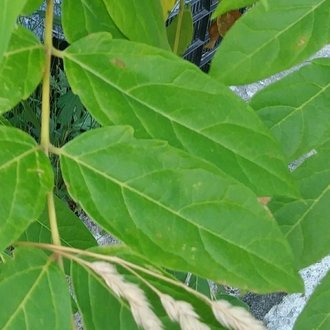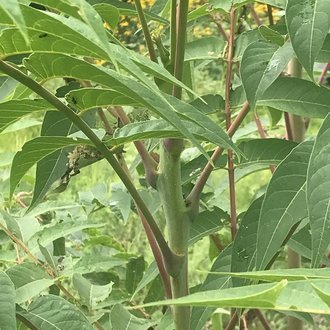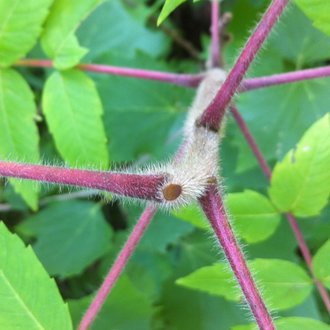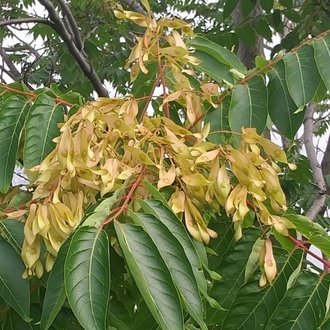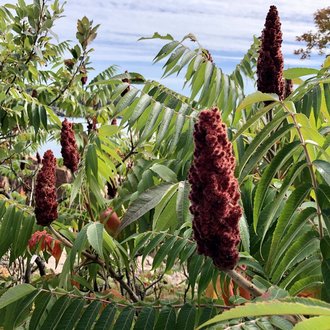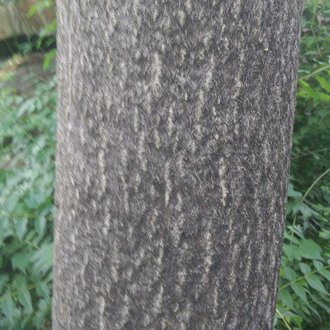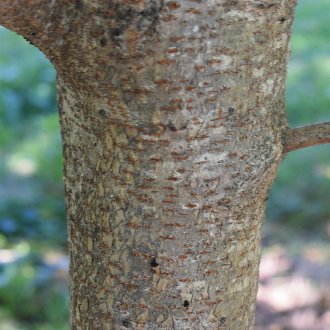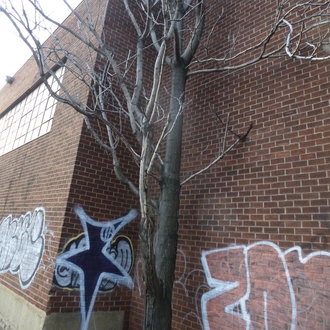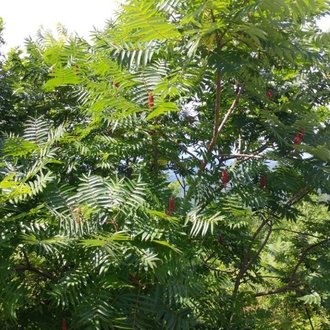Tree of Heaven vs Staghorn Sumac
These trees are sometimes confused because of similar compound leaf shape and occurrence in the same disturbed habitats, such as along roadsides and railroads. Both tend to form colonies with multiple trunks attached to a single root system. They can be easily distinguished at any time of year by leaves, twigs, bark, and fruit. Although their ranges and habitat overlap considerably, tree of heaven ranges farther west and is more common in cities and anthropogenic habitats, whereas staghorn sumac ranges farther north and is more common in natural areas farther from human influence.
Tree of Heaven (Ailanthus altissima) | Staghorn Sumac (Rhus typhina) |
A fast-growing tree, native to east Asia, and widely introduced across North America. Common in anthropogenic habitats in much of its introduced range, less common in natural areas. | A thicket-forming shrub or small tree native to eastern North America; a pioneer species preferring rocky soils. |
Leaflets have one to a few teeth at the base, but the rest of the leaflet margin is not serrated. Photo © Ira Gershenhorn, Public Domain. | Leaflet margin is serrated along its whole length. Photo © Charlie Hohn, CC BY 4.0. |
Young twigs and stems of leaves and leaflets hairless. Photo © jeffreyaewick, Public Domain. | Young twigs and stems of leaves and leaflets densely covered in hairs. Photo © Charlie Hohn, CC BY 4.0. |
Fruit a hanging cluster of dry seeds enclosed in flat structures to allow for wind-dispersal. Photo © Ira Gershenhorn, Public Domain. | Fruit a dense, upright cluster of fuzzy red berries. Photo © Ryan Kurtz, CC BY 4.0. |
Mature bark gray with slightly irregular vertical strips of a lighter color. Bark usually lacks horizontally-oriented features. Trunk can reach many feet in diameter. Photo © Ira Gershenhorn, Public Domain. | Mature bark dark gray or gray-brown, with horizontal strips (lenticels.) Bark may or may not have vertically-oriented cracks. Trunk rarely reaches more than 10 inches (25 cm) in diameter. Photo © , CC BY-SA 4.0. |
Medium-sized tree, reaching 60-70 feet (18-21m) in height. Although can exhibit shrubby growth when young or in some habitats, trunk usually grows straight and tall and self-prunes, leaving branches only higher up. Photo © Ira Gershenhorn, Public Domain. | Small tree or large shrub; rarely grows taller than 40 feet (13.7m) Trunk is shorter, branching frequently. Trunks usually lean. Photo © Ryan Watson, CC BY 4.0. |
Foliage emits a strong and often unpleasant nutty smell when crushed. | Foliage does not have a strong smell even when crushed. |
References & External Resources
These short lists show only links helpful for ID. For a complete list of references and resources also covering other aspects of ecology, visit the links section of the full article on each plant, which is the first entry here.



